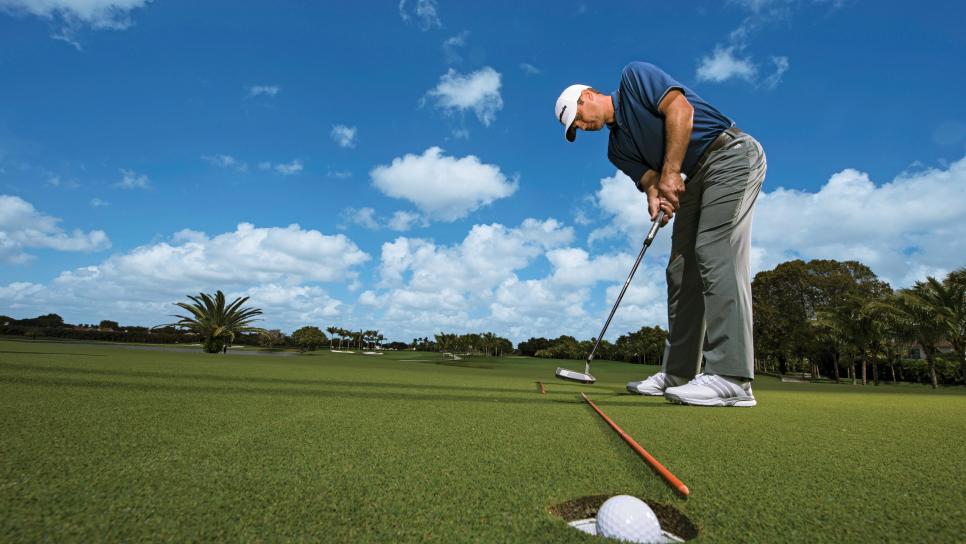Two characteristics distinguish how top tour players approach putting: (1) They pay careful attention that the putter is aligned correctly and that it contacts the ball with maximum energy—a direct hit, not a glancing blow—to produce consistent roll; (2) they replicate on-course pressure when they practice, called full-process training, to learn to make putts when it matters. Average golfers typically do neither.
To make your practice more effective, try a system I developed called Every Ball Counts that targets stroke mechanics and practice simulations. First, let's discuss what I'm showing in the photograph here. This is a drill I have my tour players do. Find a hole on a fairly flat section of the practice green, and plant tees in the ground in four lines, forming a giant plus sign. Start at four feet from the hole and continue out in one-foot increments until you place five tees in each line, from four to eight feet. That's 20 tees in all.
Drop a ball next to one of the four-foot tees, and try to hole the putt. If you make it, tap the tee halfway down. If you miss, leave the tee up. Go to another four-footer, and repeat. Putt all the four-footers first, then all the five-footers, and so on, until you've hit putts from every tee. You'll feel the pressure building. When you finish, count the tees still at full height and subtract from 20. That's your score.
Do this drill four or five times to get your average score. The average of my tour players is 14 out of 20; players who shoot in the 90s average about 10. Keep track of your score each time, and write it down to chart your improvement. Now read below, and we'll work on your stroke mechanics.—With Roger Schiffman
Let's get your putter on the correct path to roll the ball on line. For starters, understand that your through-stroke will be slightly shorter than your backstroke if you apply maximum speed at impact. In other words, the strike will slow down the putterhead.
In terms of alignment, most golfers aim to the right and cut across their putts from out to in. This is a glancing blow and doesn't propel the ball forward efficiently. Just like in the full swing, you're trying to produce energy with minimal effort. You do that with a solid strike and a square putterface.
Given the common tendency to cut across putts, most average golfers need to feel as if they're hitting draws with their putter, swinging the putterhead in to out. In reality, the putter will track from slightly inside the line to straight along the line through impact.
Lay two alignment rods on the green just wider than your putterhead and parallel with each other, aimed at a hole six feet away (shown). Place them so the front end of the outside rod is even with the ball and the back end of the inside rod is even with the ball. This allows for an in-to-out stroke path. Hit some putts from this practice station, being careful not to bump into either alignment rod. You'll groove an inside-to-straight stroke, just like the pros.

Take your time and be precise with this drill and the one previously mentioned. Remember the name of my system: Every Ball Counts. Groove your stroke here and then test it using the 20-ball drill. This organized, measurable approach encourages skill transfer from the practice green to the course. Put in some effort, and I know you'll drop more putts.
WHAT'S YOUR STYLE?
As I said above, most golfers cut across their putts. But some have the opposite problem, swinging the putter too much on an in-to-out path. If this is your issue, you need to reverse the positions of the alignment rods in this drill. To see which path you have, set two balls against your putterface—one on the toe and the other on the heel. Hit both balls with one stroke. If the inside ball (heel) gets to the hole first, you have a cut stroke. If the outside ball (toe) gets there first, you have a hook stroke. Set up your practice station accordingly.
Darren May is director of instruction at The Bear's Club in Jupiter, Fla., and works with Camilo Villegas and Cameron Tringale.
